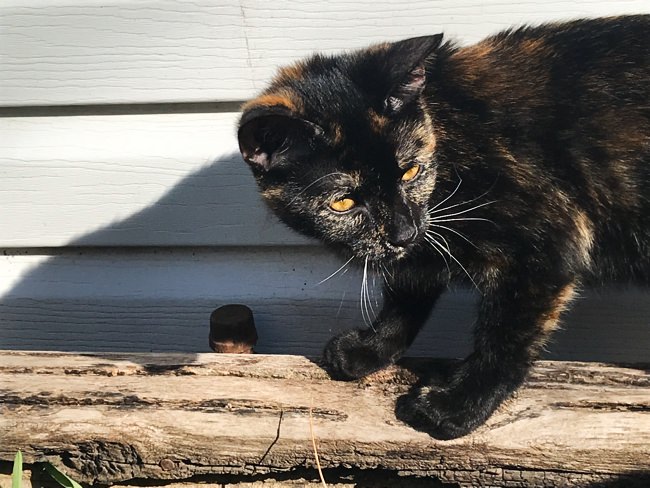How to Introduce Your Cat or Dog To Your New Home
Posted Thursday, September 23rd, 2021 | 1,771 views
Before you start moving into your new home, you’ll need to properly prepare your pets so the transition is as stress free as possible. After moving into a new home, cats and dogs are known to get stressed by the change, so it’s important to be attentive to their needs and use some of these strategies to help get them settled in again.
 The best way to introduce your pets to your new home is by talking to them as much as possible during the move and when you arrive at your new house. Pets recognize their owner’s voice, so constantly talking to them assures them that you’re not bringing them anywhere dangerous nor abandoning them in the new place either.
The best way to introduce your pets to your new home is by talking to them as much as possible during the move and when you arrive at your new house. Pets recognize their owner’s voice, so constantly talking to them assures them that you’re not bringing them anywhere dangerous nor abandoning them in the new place either.
Gather All Your Pet’s Toys and Belongings
One of the first things you’ll do is gather all your pets belongings including their toys, food, beds, blankets and the litter box for your cats. You’ll be bringing these items with you at the same time that you’re transporting your pets to your new house.
Transitioning Your Cats
Put Your Cats in a Cat Carrier
When you’re ready to bring your cats to your new home, gently place them in a carrier case, and cover the case with a blanket. The blanket will drown out the influx of the visual stimulation during the drive which can be very scary for them.
Dogs love going on car rides so transporting your dogs to your new house is not an issue.
Place Your Cats in a Room
Once you arrive at your new house, continue talking as usual and place their carrier in the corner of a room. Keep the blanket on top of it, open the door and let them come out of the case in their own time.
While they’re contemplating leaving the carrier, place their belongings in the room beside the carrier and put the litter box in the opposite corner. Make sure to place their food bowl nearby but don’t expect them to eat that day. These familiar items will slightly ease their stress but it will still take time for the shock of the move to wear off.
Once you’ve opened the carrier and placed their items in the room, leave the room and make sure to close the door behind you. You won’t want them accidentally getting out of the house while you’re bringing your furniture in. This also keeps them calmer and not running around in fear of all the big items being moved, the noises they hear or unfamiliar people.
Visit Them Regularly
Throughout the day make sure to visit your cats regularly. It’s a good idea to check in on them at least once or twice an hour. Start talking to them before you open the door so they know it’s you coming into the room.
Talk nicely to them as you usually do, and spend a few minutes playing with them. Doing this several times throughout the day will continue to assure them that they’re safe and that you’re still there with them.
When and How to Let Them Out of the Room
Once visitors or movers have left your home and things haven’t settled down, visit your cats in the room again, making sure to talk to them before you enter the room. Open the door and peak your head in and talk to them.
From there leave the door open a crack so they can start exploring the home on their own time. They will still be quite anxious and apprehensive so try to keep the commotion to a minimal and keep the noise down.
You may find that your cats won’t come out of the room for a few days, and if this is the case, simply continue visiting them, cleaning their litter box, playing with them and giving them food and water.
After a few days they’ll feel safer and more comfortable, but it may take a few weeks for them to look like they’re getting used to the new home, so be patient because they eventually will.
Transitioning Your Dogs
 Dogs can transition into new homes much easier than cats do but they can still get stressed and confused. At night, dogs like sleeping in their own beds and in their familiar places.
Dogs can transition into new homes much easier than cats do but they can still get stressed and confused. At night, dogs like sleeping in their own beds and in their familiar places.
For the first few nights they’re sleeping in the new home, they’ll still be a little confused but this only lasts a few days.
Put Your Dog’s Bed and Food in a Room at First
At first your dogs will think they’re only visiting somewhere, and will be ‘going home’ soon. Of course this isn’t the case so it’s a good idea to get them used to the new house as quickly as possible.
By placing your dogs and their items in a separate room during moving-in day keeps them calm from all the commotion, and forces them to patiently wait for you to back. As you would probably expect, as the day passes, every-time they see you, they’ll think they’re going home again.
Play with Them
Dogs can adapt to new settings—especially if they’re with their owners—pretty quickly but one way of easing the tension is to play with them. You may not have your carpet rolled out yet but you can still grab a throw-toy and play fetch with them in the living room or basement. You can also take your pups to your backyard if your sod has already been laid.
Playing with them will help get them more familiar with their surroundings and more comfortable living in the new house as each day passes.
Feeding Time
Regardless of where you’re living, you’re going to have to feed your pups. Depending on their level of stress they may not be hungry at all so the best thing to do is fill their puppy bowls up with food as you usually would, place it next to them in the room, and leave the room. They probably won’t eat but they’ll be more likely to than if you placed the bowl in the new busy kitchen.
Walk Time
Of course you’re going to have to walk your dogs, and they’ll be expecting you to at a certain time like they do every day. This is an opportunity to enforce their regular schedule with them, and to take them for a walk in the new neighbourhood. This will alleviate any stress they have by being away from home, and give them a chance to explore their curiosities.
Sleep Time
Whether you let your dogs sleep with you in your room or not, for the first few days to a week it’s a good idea to let them sleep in the same room as you. Sleeping alone at night for the first few days could throw off their schedule, and even cause them stress while they’re sleeping.
When it comes to bed time, simply bring their beds out of the room they have been in, and place it beside your bed. Even if they feel like ‘going home’ they’ll be much more relaxed and realize it’s time to go to bed.
Follow Regular Routines
When morning comes, follow your regular routine with them, like feeding and walking them. Feeding can now be done in the spot of the home you’ll choose for regular feedings, and of course you’ll walk them at their regular walking time.
In a few days they’ll start accepting their new home and pretty much forget about going back to your old house.
You Know Your Pets Best
Although we’re custom home builders, we’ve heard of and seen a lot of situations where new home owners get nervous about their pets. One of the best pieces of advice we can give you is to follow your instincts when it comes to transitioning your pets to your new house because of course as a pet owner, no one knows your pets more than you.
